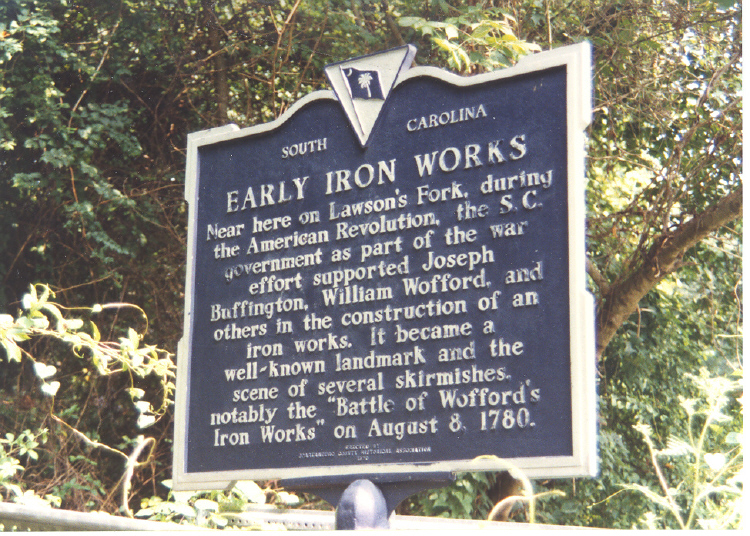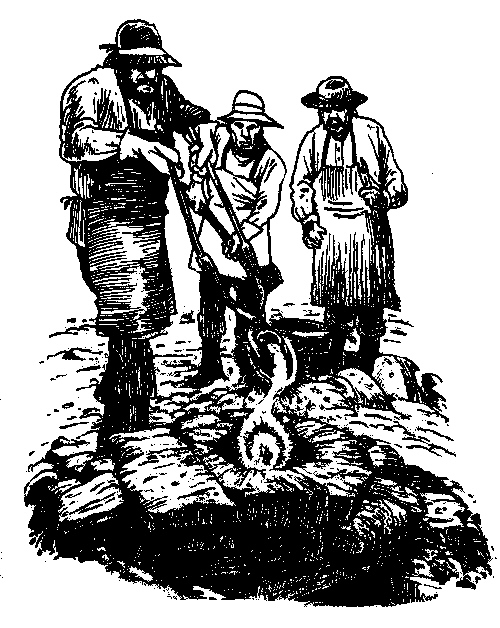
(Photo courtesy of Charles Hammett)
Public speakers and newspapers began, during the 1930's, to call Spartanburg "The Old Iron District"- for the first iron works in the State were erected in it, on Lawson's Fork, in 1773; and forges and small furnaces were operated at several places in it, during the years immediately following the Revolution. On branches of Tyger River, Michael Miller, Samuel Nesbitt, William and Solliman Hill, and the Galbraiths had forges. William and Sanford Smith had a forge on Dutchman 5 Creek, and were famed gunsmiths. William Clark and William Poole operated on branches of the Pacolet River. But the organization of two strong companies, in the early 1830's, established the preeminence of Spartanburg in iron production. In 1856 Spartanburg had four of the eight important furnaces in the State.
Iron ores, limestone, forests, and water power were the essentials of iron production; and all of these occurred close together in that section of the county which justified calling it "The Old Iron District." As a matter of fact, York was, almost equally with Spartanburg, entitled. to the appellation. The heart of the iron beds lay within the area on each side of Broad River between the North Carolina line and Smith's Ford. Within the iron district lay a part of Union County, practically all of Cherokee, a small strip of the present-day Spartanburg, and a wide strip of York. The ores were of several varieties. In the same area were quantities of limestone for fluxing, quartz rocks and beds of fire clay for furnace-building, as well as extensive forests to furnish charcoal; and all these in combination furnished a basis for a great industry. Added to these advantages was the situation on the Broad River and its tributaries, which supplied unlimited water power for operating machinery, and supplied a means for transporting the product to market.
Magnetic and specular ores in inexhaustible quantities were found on the west slope of Kings Mountain, extending into York, Union, and Spartanburg. The magnetic ore was commonly called "gray" ore, and made the best iron for bar iron or castings; the hematite ore was commonly called "brown" ore, and, although somewhat inferior in quality, was more abundant and cheaper. It was made usually into pig iron. The ore was not mined, but was dug from the surface.

In 1773 Joseph Buffington, iron master, erected a bloomery here on on Lawson's Fork because he found water power, iron ore, and abundant forest lands -all necessary to iron production. He also met with encouragement from the inhabitants, who were glad to be able to buy pots and pans and farm implements at home, and equally glad to find a cash market for their wood. Almost every farmer had a pit for burning charcoal to sell at the iron works.
The lands Buffington bought and leased for his plant lay in the region claimed by North and South Carolina before the running of the boundary line in 1772, and he had much trouble about his titles, for William Wofford had established his claim to the iron works tract on the basis of North Carolina grants. Buffington apparently operated with borrowed capital, and soon lost control of the iron works, which became known as Wofford's Iron Works, and kept that name in popular speech until burned by Bloody Bill Cunningham during the Revolutionary War in November 1781. After that it was for a time called the "old iron works."
Click on this link for a map of Iron Works location.
Click on this link for a satellite view of the Iron Works location and the Glendale vicinity.
In 1776 Buffington borrowed more than 6,000 pounds from the State to complete his plant. William Henry Drayton and many local patriots of influence endorsed his request for this loan, because they knew that iron goods were necessary to the conduct of war. It is noteworthy that, at this and other iron works built later in Spartan District, weapons and ammunition were manufactured for use in the Revolutionary War, the War of 1812, the Mexican War, and the War Between the States.
In 1778 William Wofford sold a three-fourths interest in the iron works built by Buffington to Simon and John Berwick and Charles Elliott of Charles Town, and for a brief time the name "Berwick's Iron Works" was used. The record of when the works were rebuilt and how Buffington regained control of the plant has not been found, but in 1785 an act of the legislature ordered the sale of Buffington's Iron Works, to satisfy the unpaid debt on them. Possibly at this sale William Poole acquired the works, for there can be little doubt that this same site (which is today Glendale) was that of Poole's Iron Works.
The iron industry continued on at Glendale even after the coming of the textile mill. It did not end until after the Civil War. A large cupola furnace at Glendale was used during the War to make bowie knives, swords, shot, shells tools and all sorts of special equipment. Other iron industry plants in the Upcountry were also involved in making supplies for the Confederate war effort. At the end of the War, iron making was discontinued at Glendale. This important industry had served the Upcountry for over 90 years and through two major wars.
Today, the iron industry and its contribution to the state of South Carolina is almost forgotten.
(Above from WPA ďA History of Spartanburg CountyĒ )
New Information on the Iron Works
We are pleased to make available some new information about the Iron Works. This article is based on detailed and extensive research by the author, Jim S. Brooks. He was assisted in preparing the article by his daughter, Christina Paige Brooks.
Jim was born in Spartanburg County, SC, some 70 years ago, and presently lives in Roebuck, SC. Before retirement, Jim was a lawyer in general practice with an emphasis on real estate.
Jim and Christina have a family connection to the iron industry at what is now Glendale. Jimís great-great-great-great uncle-John Brooks- operated the cupola furnace there during the Civil War. The iron produced was used by the Confederacy for war materials. (See above.)
This family connection to the iron industry at Glendale, spurred Jimís interest in the Iron Works. For over 20 or 30 years he has saved information that he ran across about the iron industry along Lawsonís Fork. He used some of the skills that he acquired in researching real estate records to uncover previously unknown information about the Iron Works. Christina had previous experience as an editor and she assisted in organizing and editing the final article.
They have produced an article that will be enlightening to anyone with an interest in the iron industry at Glendale. Click on this link to read more The Iron Works on Lawson's Fork.
Jim's work also discusses a litle known fact about the area of the Ironworks. At the beginning of the Revolutionary War, William Wofford built a fort there that was used as protection against the Cherokee Indians. Read the details about this at Wofford's Fort.

This web site has been started as a public service to share the story of Glendale. See more information about Mary and her Glendale connection at Mary McKinney Teaster.